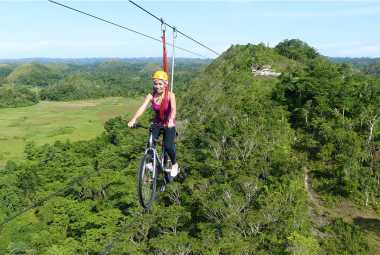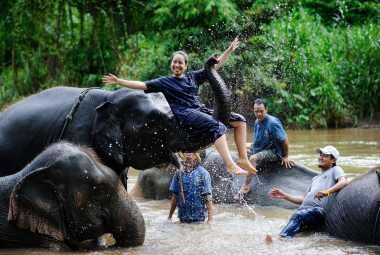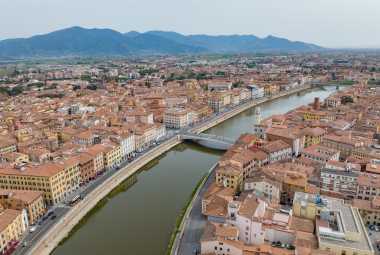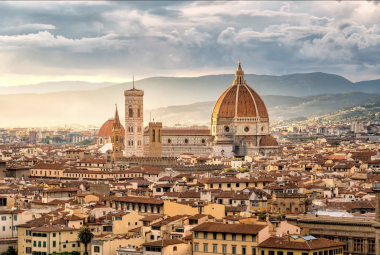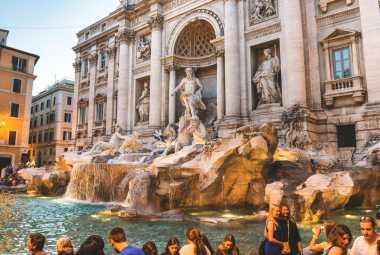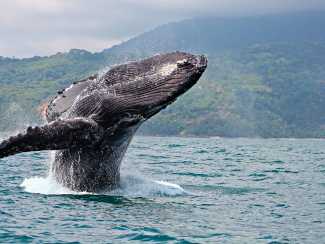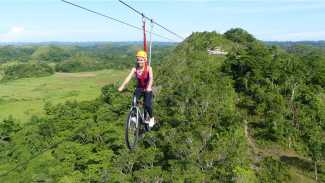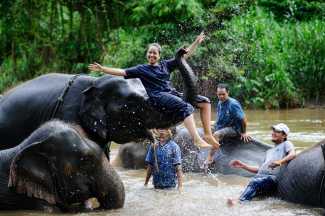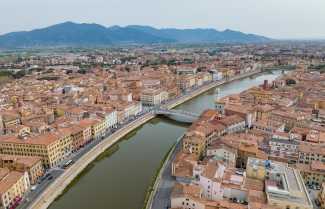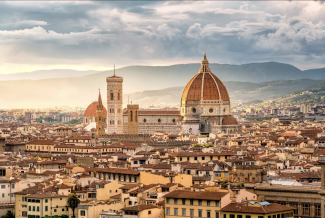Image by hotels.com
*Vacation Mode is a for-profit site. It contains paid banner advertisements that are generated and managed by a third-party network. This site also includes relevant affiliate links (both in the content and on the sidebar) all of which we do our best to clearly mark as such.
Costa Rica or Chile? Both are beautiful countries with amazing attributes. Costa Rica offers lush rainforests and stunning beaches. Chile is known for its diverse landscapes and incredible natural wonders. Which one should you choose for your next holiday?
If you're after a tropical paradise, go for Costa Rica. It has pristine beaches and warm turquoise waters. Plus, it's famous for its rich biodiversity. You can do hiking in cloud forests and spot exotic wildlife.
If adventure and exploration are more your thing, try Chile. It stretches from the arid Atacama Desert to the breathtaking Patagonia region. There's the otherworldly landscapes of the Atacama Desert or the glaciers of Torres del Paine National Park. You can even go skiing in the majestic Andes Mountains.
Here are some suggestions based on your preferences:
- Manuel Antonio National Park in Costa Rica has stunning beaches and diverse flora and fauna.
- Valparaiso in Chile has vibrant street art, charming neighborhoods, and views of the Pacific Ocean.
- Casablanca Valley and Colchagua Valley wine regions in Chile have exquisite vineyards and breathtaking scenery.
Ultimately, whichever you decide, you'll have an unforgettable experience. Pack your bags and get ready to go!
Brief Overview of Costa Rica
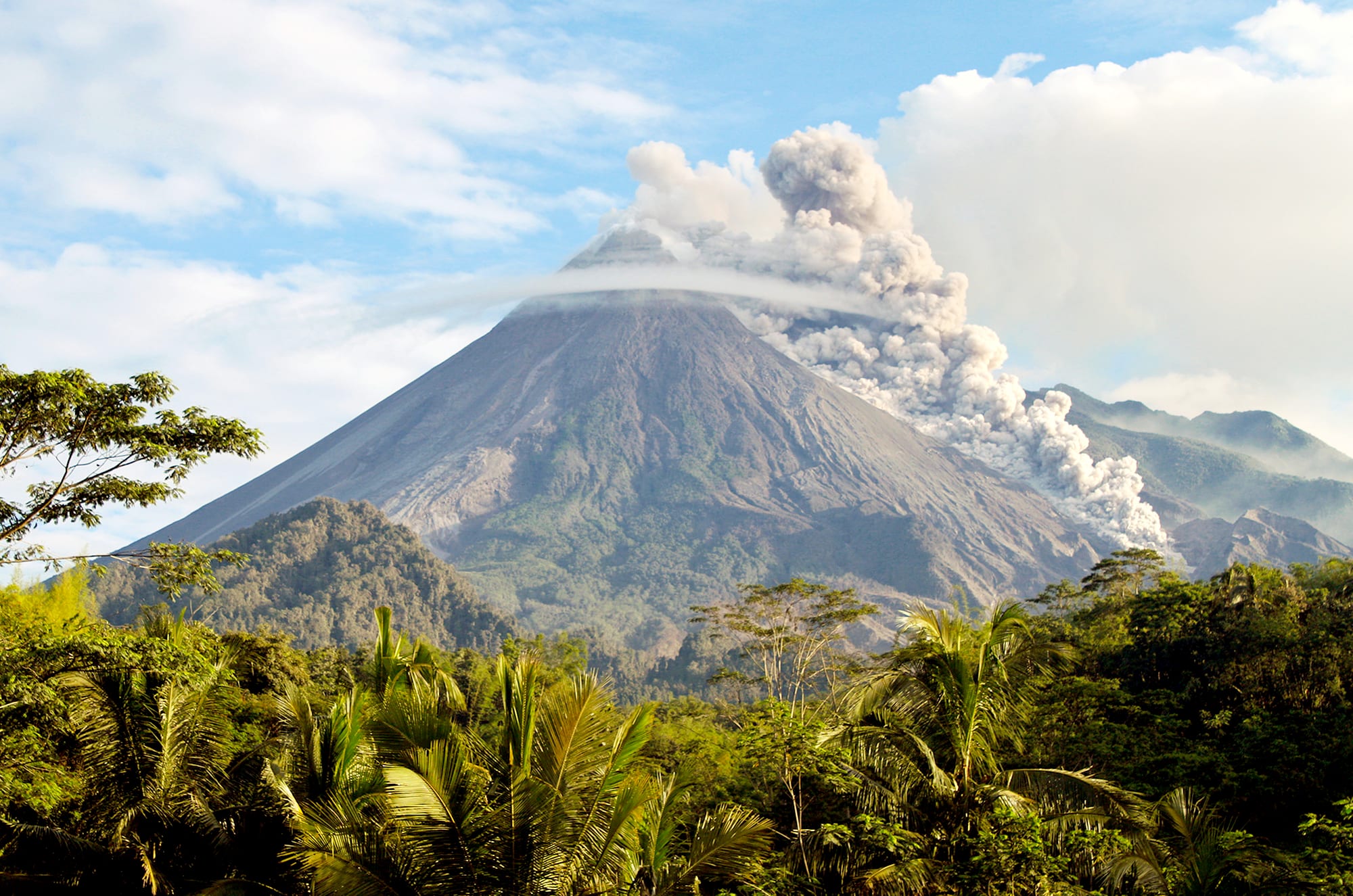
Costa Rica is a small, yet attractive Central American country. It offers lots of natural sights and cultural experiences. With its biodiversity and environmental sustainability, it's become a favorite destination for eco-tourists.
Between the Caribbean Sea and the Pacific Ocean, Costa Rica has white sand beaches, lush rainforests with exotic wildlife, and volcanoes to explore. Adrenaline-seekers can try zip-lining through the forest or surfing. Relaxation seekers have tranquil retreats to unwind in.
Costa Rica is known for their eco-friendly practices. They've made good progress in renewable energy production and carbon neutrality. Visitors can see this sustainable effort by staying in eco-lodges or joining conservation projects.
Costa Rica also has a rich cultural tapestry from indigenous traditions and Spanish heritage. There are festivals, fresh tropical flavors, and friendly Ticos and Ticas.
Tip: Don't forget Monteverde Cloud Forest Reserve and Tortuguero National Park. They offer one-of-a-kind wildlife encounters and natural landscapes. Pack your bags and take an amazing journey to this paradise!
Brief Overview of Chile
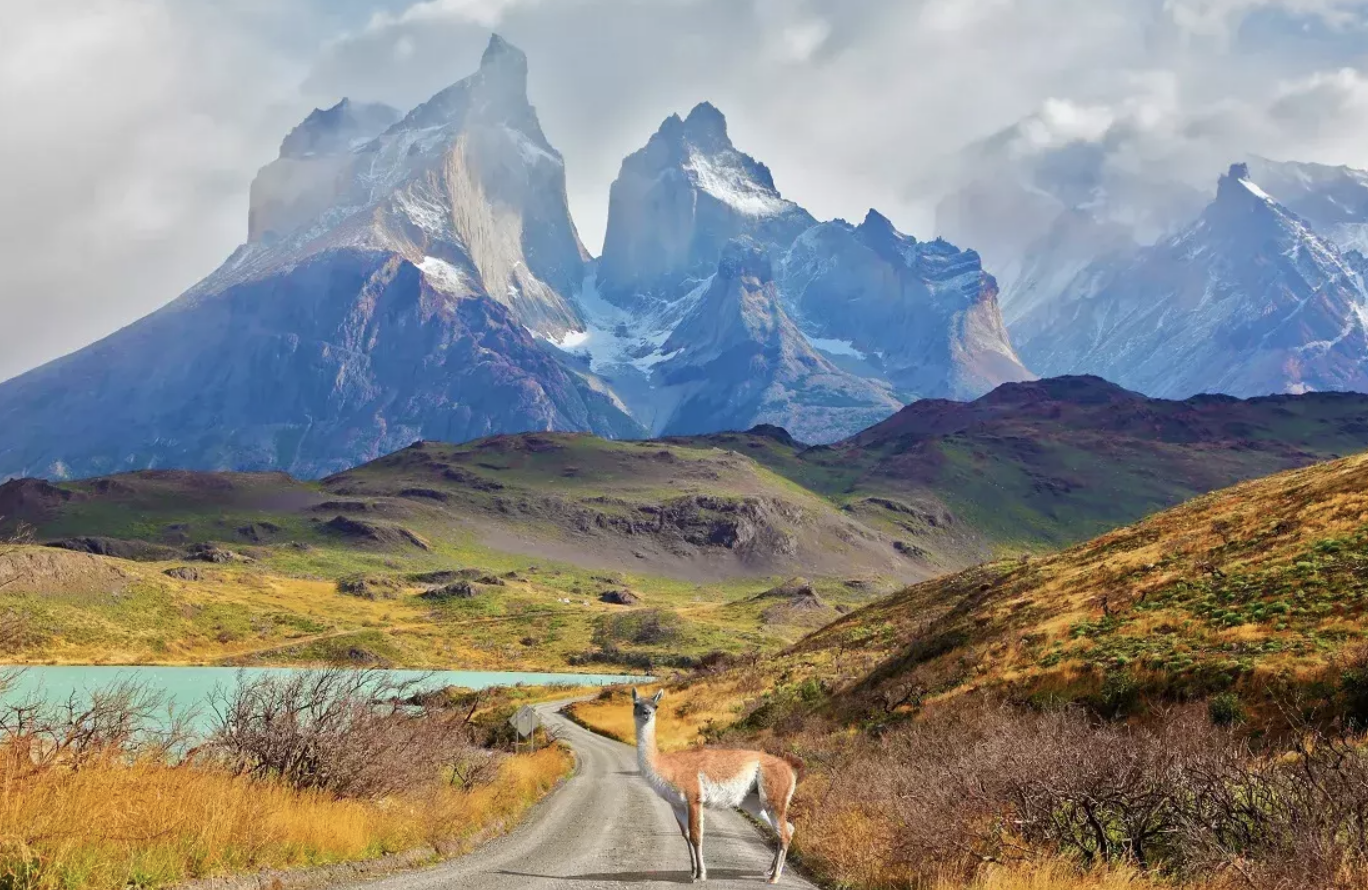
Chile, an alluring South American country, presents a captivating range of landscapes. It flaunts breathtaking natural beauty - the Andean mountains, striking deserts, and tranquil lakes. Chile is renowned for its gorgeous geographical features - from Patagonia's icy glaciers to the Atacama Desert - one of the driest places on Earth. Nestled between the Pacific and the majestic Andes, it offers exciting outdoor activities including hiking trails with stunning views.
Chile's culture is enriched by influences from indigenous groups and Europeans. Santiago, the capital, is a lively city with art galleries, museums, and theaters. Music and dance play an important role in the local culture, with traditional dances like cueca captivating audiences.
Chile has experienced both triumphs and challenges in its history. One significant event was the 1973-1990 military dictatorship led by General Augusto Pinochet. This period brought great political unrest and human rights violations, which continue to influence Chilean society.
Climate and Geography
To understand the climate and geography of Costa Rica and Chile, explore the distinctive features of each region. Discover the climate variations in Costa Rica and Chile, as well as the geographical characteristics of both countries. Uncover the unique aspects of the climate and geography in Costa Rica and Chile.
Climate in Costa Rica
Costa Rica is known for its beautiful landscapes and extraordinary biodiversity. It has a wide range of climates, from the lush rainforests to the sandy beaches, to fit everyone's preferences.
The northern area of the country, with its lowlands and coastal regions, has a tropical climate with hot temperatures and humidity all year round. The wet season is usually from May to November with rains that nurture the rich flora and fauna.
The central highlands have milder temperatures and less humidity, making it ideal for outdoor activities. The dry season is from December to April with less rainfall.
The Pacific region has a transitional climate due to its closeness to the Caribbean Sea and Pacific Ocean. Wet and dry seasons are shorter here, with lighter rains than in other parts of Costa Rica.
If you want cooler temperatures and foggy skies, visit the high altitudes near Monteverde and Arenal. These places have unique microclimates with different weather than the rest of the country.
To make the best of Costa Rica's climates, remember these tips:
- Pack the right clothes. For places like Guanacaste or Nicoya Peninsula, wear lightweight breathable fabrics.
- Know the seasons. If you want to explore rainforests, come during the wet season. If you want beaches, come during the dry season.
- Layer up. For those transitioning between regions, layering your clothes will help you stay comfy.
By understanding the climates and planning your trip accordingly, you can get the full Costa Rican experience! Whatever climate you seek, Costa Rica has you covered.
Climate in Chile
Chile has a diverse climate, due to its unique geography. In the north, it's arid and desert-like, with almost no rain. Moving towards the centre, it has a Mediterranean climate, with hot summers and mild winters. Further south, the climate is cooler and wetter with forests and lakes.
Plus, Chile's shape leads to temperature differences. The north gets really hot in the summer, while the south provides cool relief.
Travelers should remember to pack layers for the varying climates. Be prepared for anything!
Geography of Costa Rica
Costa Rica is a land of diverse and captivating geography. It has stunning landscapes ranging from volcanic ranges to coastal plains. This Central American nation offers a unique mix of natural wonders. Let's take a closer look at Costa Rica's geographical features!
Geography of Costa Rica:
| Feature | Description |
|---|---|
| Location | Central America, between Nicaragua and Panama |
| Area | 51,100 square kilometers |
| Coastline | 1,290 kilometers of picturesque coastline |
| Mountains | Cordillera de Talamanca and Guanacaste |
| Volcanoes | Arenal and Irazu |
| Rainforests | Lush green rainforests with remarkable biodiversity |
Costa Rica is also known for its various microclimates. From tropical rainforests to misty cloud forests, this small country has a great variety of climates.
To make the most of Costa Rica's geography, here are some ideas:
- Check Out Volcanic Beauty: Climb the slopes of Arenal Volcano or explore Irazu National Park to witness the power and majesty of volcanoes. Don't forget to take pictures!
- Do Ecotourism: Find the rich biodiversity in Costa Rica's rainforests. Go to national parks such as Corcovado or Manuel Antonio to have close encounters with exotic animals like sloths, toucans, and howler monkeys.
- Dive Into Coastal Delights: Dive into the crystal-clear waters along Costa Rica's coast. Have fun snorkeling, diving, or simply sunbathing on Tamarindo or Manuel Antonio's beaches.
By exploring the remarkable geography of Costa Rica and following these tips, you can make wonderful memories and experience the natural wonders of this country!
Geography of Chile
Discover the remarkable geography of Chile! This South American nation's coast is 6,435 kilometers long, and its highest point is Mount Ojos del Salado at 6,893 meters. Its lowest point is the Pacific Ocean at 0 meters.
Chile's climate varies from desert to Mediterranean. It has the Atacama Desert in the north--a stark, arid expanse. In the south, it boasts fjords and glaciers in Patagonia.
Pro Tip: As you explore Chile, be sure to pack clothes for the various climates.
Natural Attractions
To explore the natural attractions of Costa Rica and Chile, delve into each country's unique landscapes and breathtaking wonders. Discover the captivating natural attractions of Costa Rica, and then immerse yourself in the awe-inspiring beauty of Chile's natural wonders.
Costa Rica's Natural Attractions
Costa Rica is a tropical paradise with captivating natural attractions that will amaze you. From beaches, forests and volcanoes, to a vast array of wildlife, this place has it all. To appreciate the beauty of the country, here's some information about its main attractions:
Tortuguero National Park, located on the Caribbean coast, is renowned for its sea turtles nests and exotic wildlife.
Arenal Volcano National Park, situated in the northern region, is an active volcano with amazing views, hot springs and exciting hiking trails.
Monteverde Cloud Forest Reserve in Puntarenas province is an enchanted forest with a wide variety of species. You can enjoy canopy tours while watching hummingbirds and monkeys.
Manuel Antonio National Park in the central Pacific coast is the perfect combination of white sand beaches and dense rainforest. Here you can admire monkeys, sloths and a variety of marine life.
Aside from its natural attractions, you can also explore Costa Rica's indigenous culture. Visit the Bribri tribe in Talamanca or take a night tour to see nocturnal creatures.
To make the most of this experience, stay in eco-friendly accommodations that promote sustainable practices. This helps to preserve the natural attractions and allows you to connect with nature.
Rainforests and Biodiversity
Rainforests are a treasure trove of biodiversity - they contain a wide range of plants and animals. Let's explore the richness of rainforests!
Here's some amazing facts about them:
- 6% of Earth's surface is rainforest.
- Over 80,000 plant species.
- Millions of animal species.
- 50% of species are found nowhere else.
- 20% of oxygen production.
Did you know? The Amazon rainforest produces more than half of the planet's oxygen. It's the home of indigenous communities living in harmony with nature for centuries.
Tip: When visiting a rainforest, take a guided tour led by knowledgeable experts. They can tell you about the delicate balance of the ecosystem.
Beaches and Coastlines
Beaches and coastlines abound in stunning beauty and tranquility! Clear waters, golden sands, and incredible cliffs make these coastal areas a paradise for nature-lovers. Here's a few things to enjoy:
- Pristine Beaches: Dive into the untouched beauty of these beaches! Soft sand and turquoise waters provide a perfect setting for relaxation and recreation.
- Wildlife Diversity: Discover the diverse marine life in the coastal waters! Snorkel or scuba dive to witness vibrant coral reefs, colorful fish, and sea turtles or dolphins.
- Coastal Activities: Enjoy sailing, kayaking, or paddleboarding along the coastline. The gentle waves and favorable winds make it ideal for water sports.
- Dramatic Cliffs: Marvel at the awe-inspiring cliffs lining some coastlines. These impressive rock formations create breathtaking views against crashing waves.
- Sunset Magic: Witness nature's masterpiece! Admire the vibrant colors painted across the sky as the sun sets over the horizon.
- Serene Atmosphere: Escape bustling city life and embrace the peaceful ambiance of beaches and coastlines. Find solace in connecting with nature while enjoying moments of tranquility.
Don't miss [Source Name], an expert guide to coastal tourism, offering insight into hidden gems and must-visit spots. Embrace the beauty and serenity offered by beaches and coastlines around the globe!
Volcanoes and Geothermal Springs
Volcanoes and geothermal springs fascinate us with their power of nature. Let's have a look at some facts about them both:
| Feature | Volcanoes | Geothermal Springs |
|---|---|---|
| Formation process | Tectonic plate movements | Underground water heated by magma |
| Location | Tectonically active regions | Areas with high geothermal activity |
| Types | Composite, Shield, Cinder, Caldera | Hot springs, fumaroles, mud pots |
| Eruptions | Explosive or effusive | No eruptions; just hot water and gases |
| Impact | Devastation but enriches soil | Renewable energy and therapeutic benefits |
Volcanoes can cause air pollution through ash and gases, however they enrich the soil, making it perfect for farming. To explore these wonders safely, it is best to visit national parks or protected areas. Hiking trails give you an up-close experience and guided tours provide safety.
Bathing in geothermal springs can relax and heal. The mineral-rich waters soothe muscle soreness, improve circulation and relieve stress. But be sure to follow guidelines for bathing duration and temperature limits.
By understanding these phenomena, we can connect with the Earth's power and witness its ability to create and sustain life. Let's appreciate and protect these attractions for future generations to enjoy!
Chile's Natural Attractions
Chile, a country in South America, has extraordinary natural attractions. From mountains to lakes and glaciers, Chile has a huge range of natural sights. Let's explore some of them!
Patagonia National Park: Located in southern Chile. You can find towering peaks, glaciers and open spaces here.
Easter Island: In the Pacific Ocean. It has mysterious stone statues (Moai) and stunning volcanic landscapes.
Atacama Desert: Found in northern Chile. This is the driest desert in the world with one-of-a-kind geological formations and starry night skies.
Torres del Paine National Park: In the south of Chile. It has famous granite peaks (Towers of Paine), lakes and lots of animals.
In addition, there are secret places like the Marble Caves in General Carrera Lake and Juan Fernández Islands with rare plants and animals.
A tip: Check the weather before visiting Chile's natural attractions - it can be different from one region to another.
Patagonia and Glaciers
Patagonia, located in the southern end of South America, is renowned for its breathtaking landscapes and stunning glaciers.
These include the Perito Moreno Glacier and the Upsala Glacier, both offering a sight like no other with their immense size and captivating blue hues.
Witness the dramatic calving of these glaciers, as chunks of ice break off and crash into the waters around them.
The Perito Moreno Glacier continues to grow despite global warming, making it a source of fascination for scientists.
Visitors can also explore majestic mountains, crystal-clear lakes, and expansive grasslands.
Unleash the unique wildlife of this region, including penguins, sea lions, guanacos, and numerous bird species.
Experience the raw and untouched nature of Patagonia, providing an opportunity for adventurers to immerse themselves in unforgettable experiences.
Did you know? The name "Patagonia" originates from the word "patagón," which was used by early European explorers to describe the indigenous people they encountered in this area.
Atacama Desert
In the mysterious land of natural attractions lies the enchanting Atacama Desert. Its beauty and unique ecosystem make it a destination like no other.
Let us explore some of its remarkable features:
- Extreme Dryness: It's one of the driest places on Earth.
- Salt Flats: They stretch further than the eye can see.
- Geysers: Witnessing their powerful eruptions is thrilling.
- Unique Wildlife: Despite its harsh conditions, the desert is home to many unique plants and animals.
The Atacama Desert also holds another surprise: its astronomical significance. Its high altitude and lack of light pollution make it an ideal spot for stargazing and research. The European Southern Observatory even operates several telescopes in the desert, unleashing new possibilities for scientific exploration.
From its striking landscapes to its extraordinary diversity, the Atacama Desert beckons with its many wonders. It is a captivating destination for curious adventurers and astronomy enthusiasts.
Easter Island
Easter Island is a remarkable place that enthralls visitors with its beguiling history and gorgeous natural beauty. This magical island, located in the Pacific Ocean, has a plethora of one-of-a-kind attractions.
Let's gain insight into some incredible facts about Easter Island:
- This isolated spot is renowned for its iconic stone statues called Moai. These enormous figures were built by the native Rapa Nui people centuries ago and are still a source of wonder and puzzlement today.
Plus, Easter Island boasts stunning landscapes that show its volcanic origins. From sheer cliffs to pristine beaches, this tropical paradise has diverse natural wonders. Exploring its lovely coastline will reveal secret caves, awesome viewpoints, and magnificent rock formations.
A spellbinding aspect of Easter Island is its remoteness. Placed over 2,000 miles from any major landmass, it is one of the most distant inhabited places on Earth. This distance has helped to preserve its peculiar culture and customs.
Now let's discover an amazing true story about Easter Island. In 1955, Thor Heyerdahl went on an expedition to test his idea about the ancient inhabitants' relocation to the island using rafts. His incredible voyage on the Kon-Tiki raft demonstrated the audacity and resolution of early seafarers and illuminated the island's mysterious past.
Easter Island is certainly a captivating destination that offers a mix of historical interest and natural magnificence. Whether you're enchanted by old civilizations or just searching for stunning landscapes, this extraordinary island will astound you with its beauty and obscurity.
Cultural and Historical Sites
To uncover the cultural and historical sites in Costa Rica and Chile, dive into the rich heritage of these nations. Discover the captivating cultural sites in Costa Rica and delve into the enthralling cultural sites in Chile. Explore the diverse narratives and architectural marvels that showcase their unique histories and traditions.
Cultural Sites in Costa Rica
Costa Rica is bursting with cultural sites that show the country's incredible history and traditions. Here are five remarkable places to visit:
- Uncover the mysteries of Guayabo National Monument. See its stone streets, and discover ancient artifacts from its indigenous past.
- Admire Cartago's Basilica de Nuestra Señora de los Ángeles. It attracts thousands of pilgrims every year.
- Visit El Castillo de la Candelaria's ruins. This fortress protected San Juan from pirates. Imagine the battles fought within its walls.
- Explore Barrio Amón in San Jose. Its elegant mansions date back to the coffee boom.
- Go to Finca 6 Archaeological Site on Nicoya Peninsula. Admire the stone spheres crafted by pre-Columbian cultures - what was their purpose?
These places offer a peek into Costa Rica's past. Don't miss out on these extraordinary destinations for an unforgettable travel experience!
Pre-Columbian Archaeological Sites
Before Christopher Columbus arrived, the Americas held a wealth of history and culture, reflected in Pre-Columbian archaeological sites. These sites possess priceless artifacts, revealing the native civilizations that flourished across the continents.
A table below displays some of these remarkable sites, showing their locations, time periods, and remarkable features:
| Site | Location | Time Period | Notable Features |
|---|---|---|---|
| Teotihuacan | Mexico | 1st - 7th century | Pyramid of the Sun, Avenue of the Dead |
| Machu Picchu | Peru | 15th century | Incan ruins atop a mountain |
| Chichen Itza | Mexico | 10th - 15th century | El Castillo pyramid, The Great Ballcourt |
| Tikal | Guatemala | 4th -10th century | Temples, pyramids, and plazas |
| Cahokia | United States | 11th -14th century | Monks Mound, Woodhenge accompany |
For instance, Teotihuacan in Mexico has the Pyramid of the Sun and Avenue of the Dead. Peru's Machu Picchu is an incredible Incan ruin atop a mountain. Chichen Itza in Mexico is home to the El Castillo pyramid and The Great Ballcourt. Tikal in Guatemala has temples, pyramids, and plazas. Lastly, Cahokia in the US features Monks Mound and Woodhenge.
Pro Tip: For an educational experience, seek a knowledgeable guide when visiting these Pre-Columbian archaeological sites.
Colonial Architecture
Colonial Architecture - part of our cultural legacy - exhibits the architectural styles and influences from the colonial era. Let's check out some stunning samples of this architecture that still mesmerize people worldwide.
Look at this table for some remarkable colonial architecture structures from various countries:
| Country | Structure | Architectural Style |
|---|---|---|
| United States | Independence Hall | Georgian |
| India | Victoria Memorial | Neo-classical |
| Brazil | Palácio do Planalto | Modernist |
| Australia | Old Government House | Palladian |
Apart from the usual structures, other unique colonial buildings include St. Augustine in Florida - the oldest continuously occupied European-established settlement in the US. The Sucre Cathedral in Bolivia, a beautiful example of neo-Gothic architecture.
Don't miss your chance to see these awe-inspiring colonial architectural masterpieces. They tell the story of our rich history and cultural heritage. Plan your next trip to enjoy these priceless gems that combine beauty, history, and craftsmanship.
Indigenous Cultures
Dive into the vibrant world of Indigenous Cultures! Experience their unique customs and practices, like language, art, dance, and rituals. Understand the nuances to appreciate the diverse tapestry they weave - a web of knowledge systems, spirituality, and interconnectedness with nature.
Embark on this extraordinary journey to explore the captivating tapestry of these cultures and discover the incredible wisdom held within their traditions. Don't miss out on the richness that awaits you on this enlightening adventure!
Cultural Sites in Chile
Chile is brimming with a unique cultural heritage, offering plenty of intriguing sights to explore its history and customs. Check out these must-see destinations to get a glimpse of the country's culture:
- Valparaiso: This port city presents bright colors, street art and hillside architecture.
- Easter Island: Home to the famous Moai statues, this remote island offers a chance to discover Polynesian culture and ancient archaeological sites.
- La Chascona: Visit Pablo Neruda's former home which now serves as a museum exhibiting his art collection and personal items.
- Santa Lucia Hill: This historic hill in Santiago treats you to a scenic park and splendid views of the city.
- Church of San Francisco: This 16th century church in Santiago showcases Baroque architecture and religious art.
To get a better understanding of Chile, pay a visit to the Mapuche communities spread across the country to learn about their language, customs and craftsmanship. Here are some tips to get the most out of your cultural journey in Chile:
- Talk to locals: Connect with people to gain insight into their lifestyle and customs.
- Attend cultural events: Look out for festivals, parades or performances to enjoy Chilean music, dance and cuisine.
- Take guided tours: Sign up for guided tours provided by knowledgeable guides.
- Try traditional food: Sample some local delights such as empanadas or completo.
- Explore local markets: Visit bustling markets like La Vega Central or Feria Fluvial to buy handicrafts, taste exotic fruits and meet vendors and shoppers.
By engaging with the local community and exploring Chile's cultural sites, you will not only get to know the country's heritage but also gain an appreciation of its people and traditions.
Chiloé Island and Its Churches
Chiloé Island, off the coast of Chile, boasts a captivating array of churches that are historically and culturally important. These wooden churches possess a unique mix of native and European architecture, making them one-of-a-kind.
- The craftsmanship of local artisans is visible in the intricate carvings and vibrant colors found on every church.
- The architecture is a combination of Mapuche design elements and Spanish colonial influences.
- These churches served as meeting points for the island's communities, where people could worship and communicate.
- Many churches are UNESCO World Heritage sites, to honour their cultural value.
Chiloé Island also has stunning natural beauty. Forests, beaches, and fishing villages await visitors. Plus, you can sample the region's delicious and traditional seafood dishes.
Now, I want to tell you a fascinating story about one of these churches. Iglesia de Nuestra Señora de Gracia de Rilán has an intriguing tale. In the 19th century, workers attempted to build its bell tower higher than the one in Castro church. But, mysterious winds kept knocking it down. After multiple attempts, they gave up trying to surpass Castro. This church stands today as a reminder of nature's might and human tenacity.
Valparaiso's Historic Quarter
Valparaiso's Historic Quarter is a trove of culture and history, inviting tourists to explore its past. Let's look at some of the notable highlights:
- Architecture: This area boasts an array of styles, from neoclassical to Victorian, each building a storyteller of the city's history.
- Street Art: Valparaiso is renowned for its street art, with alleys of captivating murals and graffiti.
- Paseo Gervasoni: This promenade offers spectacular views of the coast. It's lined with cafes and hotels, the perfect spot to relax.
- Cultural Hub: The Historic Quarter is full of art galleries, theaters, and museums. Enjoy local arts and crafts or catch a show.
Now for a tale of the quarter's allure:
As the sky turned dark, I found a door between two buildings. I opened it and was taken aback in time. Inside was a secret bar, hidden from view for decades.
The room was dimly lit with vintage photos and antique furniture. I had walked into a speakeasy, once a meeting point for intellectuals. I heard tales of clandestine meetings, artistic revolutions, and forbidden love.
An elderly gentleman at the bar shared stories of the city's past, of vibrancy and fervor. I had glimpsed Valparaiso's soul still beating in its Historic Quarter.
Valparaiso's Historic Quarter invites adventurers to discover its secrets and immerse in its history. It's a journey through time, with hidden gems like that speakeasy.
Indigenous Mapuche Culture
The Indigenous Mapuche Culture is a significant part of cultural and historical sites. To gain insight, a table could include columns such as Mapuche traditions, language, clothing, art forms, and religious practices. For example:
| Mapuche Traditions | Mapudungun Language | Poncho & Ruana Clothing | Woodcarving & Pottery Art Forms | Spiritual Rituals & Symbolism |
|---|
Additionally, the Mapuche people have a strong connection to nature. Their respect for ancestral traditions preserves their culture. To learn more, one can participate in spiritual ceremonies and festivals with traditional music and dance performances. Supporting artisans and purchasing traditional crafts helps the economy and preserves cultural heritage.
By learning about and supporting the Indigenous Mapuche Culture, we contribute to a diverse and inclusive society. Exploring their history can foster mutual understanding and appreciation for different cultures while celebrating our shared humanity.
Outdoor Activities and Adventure
To make the most of your outdoor adventure in Costa Rica or Chile, explore the sub-sections that detail the thrilling activities available. Discover the diverse range of outdoor activities in Costa Rica, where you can immerse yourself in nature. In Chile, experience a different kind of adventure with a wide array of exciting activities to choose from.
Outdoor Activities in Costa Rica
Costa Rica, a paradise for thrill-seekers, has something for everyone! Zip-lining through lush rainforests, taking surfing lessons on crystal-clear beaches, snorkeling in vibrant reefs, and hiking along scenic trails are all great ways to explore the country's natural wonders. For the daring, why not try white-water rafting down raging rapids or an unforgettable canopy tour high above the ground? Horseback riding is also an option for those looking for a more tranquil adventure. Bird-watchers should check out Costa Rica, as its 0.03% landmass contains 5% of the world's biodiversity!
Hiking and Wildlife Watching
Hiking and wildlife watching - two popular outdoor activities - let people immerse themselves in nature while exploring and observing different plants and animals. Enthusiasts enjoy a unique adventure and gain a greater appreciation for the natural world.
- Hiking lets individuals traverse diverse terrain - from lush forests to rugged mountains - providing an exciting and testing experience. It's also a great way to get fit while taking in stunning views!
- Wildlife watching lets people observe animals in their natural environment, helping them understand behaviors and ecosystems. It can be done with a guide or alone, depending on preference.
- On hikes, one may come across various wildlife species such as deer, birds, and even predators like bears and mountain lions. This adds a thrilling element of surprise!
- Both activities promote fitness, mental well-being, and environmental awareness. They provide an escape from modern life and an opportunity for self-reflection.
To make the most of your outing:
- Wear suitable clothing for the weather.
- Pack essentials such as water, snacks, sunscreen, insect repellent, binoculars, and a camera.
These activities let people connect deeply with nature, while benefiting from being outside. So why wait? Get your boots on, grab your binoculars, and have an amazing journey!
Zip-lining and Canopy Tours
Zip-lining and Canopy Tours have become a must-have for thrill-seekers. Soar through the air on a cable, and experience nature from a whole new perspective with these adrenaline-pumping activities!
- 1. Zip-lining offers a liberating feeling and an unbeatable view of the landscape.
- 2. Canopy Tours let you explore the treetops from high above the forest floor.
- 3. Conquer your fears and push personal boundaries with both activities!
For an extra dose of adventure, why not try zip-lining or canopy tours? Glide and explore - these activities will leave you with unforgettable memories.
Fun fact: these activities have been around since ancient times. Indigenous cultures used them for transportation and hunting. Now, anyone can embrace their inner adventurer with these thrilling recreational pursuits.
Surfing and Water Sports
Surfing and water sports are awesome outdoor activities that give a thrilling experience. Whether you're surfing or diving, it's a unique way to bond with nature and have an amazing adventure.
Jet skiing and wakeboarding are also thrilling water sports to try. Jet skiing lets you speed across the waves, and wakeboarding is like water skiing and snowboarding all in one.
For the best surf or water sport experience, here are some tips:
- Learn properly: Get lessons from instructors who can teach you safe techniques for each activity.
- Research: Look up tides, currents, weather, and hazards before going out.
- Wear proper gear: Invest in quality equipment that fits and is suitable for the activity. Wear helmets, wetsuits, and life jackets to reduce the risk of injury.
- Respect the environment: Don't damage coral, dispose of trash responsibly, and follow rules to ensure sustainable enjoyment.
Follow these tips and have a safe and unforgettable aquatic journey!
Outdoor Activities in Chile
Chile is a hiker's paradise - trek its diverse landscapes, including Torres del Paine National Park and Villarrica Volcano. Surfers can ride the waves at Pichilemu or Arica. Kayakers can explore the lakes and rivers, like Futaleufu River or northern Patagonia fjords.
For an added thrill, try sandboarding in the Atacama Desert, horseback riding in valleys, or wildlife spotting in national parks. Prepare with gear and safety guidelines, and consider hiring experienced guides to ensure safety and provide insights.
Chile offers something for everyone - adrenaline junkies and nature-lovers alike. Create unforgettable memories with thrilling outdoor activities!
Trekking in Torres del Paine National Park
Trekking in Torres del Paine National Park is an amazing adventure! Head off on rugged trails, stare in wonder at towering peaks, and uncover hidden lakes. The park offers numerous trekking paths to suit all ability levels.
As you start your trek, be ready to be awed by the scenery! The enormous granite towers of the Paine Massif loom above a beautiful blue sky, making a dazzling backdrop for your travels. Don't forget your camera - each step will bring you to beautiful scenes that need to be captured!
One amazing thing about trekking in Torres del Paine National Park is that you can come across wildlife. Keep an eye out for guanacos gracefully eating the grassland, and secretive pumas in dense vegetation. This connection with wildlife will make your experience even more special.
To make sure you don't miss out, plan your trip ahead of time. Book lodgings within the park or nearby to get the most of your time exploring. With limited spaces, book early to secure your spot as many adventurers are drawn to the beauty of Torres del Paine.
Going on a trekking journey in Torres del Paine National Park will surely leave you in awe and wanting more. Don't let doubt keep you from living this once-in-a-lifetime journey. Take the chance and immerse yourself in the untouched beauty of one of nature's greatest works.
Skiing and Snowboarding in the Andes
Skiing and snowboarding in the Andes? A thrilling adventure awaits you! These majestic mountains with pristine snow create the perfect conditions for a one-of-a-kind winter experience.
For more details, the Argentinian Andes have higher elevations than the Chilean side. This means longer ski seasons and superb quality snow. Plus, each region has many ski resorts suited to everyone's skillset.
Fun fact: Cerro Catedral in Argentina is the largest ski resort in South America! It has 120 kilometers of slopes, which make it a popular spot for all kinds of travelers.
Whitewater Rafting in the Futaleufú River
The Futaleufú River is renowned for its thrilling whitewater rafting. Adventurers from around the world come to experience the adrenaline-pumping rapids, ranging from Class II to Class V. This river offers stunning landscapes and pristine wilderness plus mesmerizing turquoise water.
For a safe, memorable rafting trip, follow these suggestions:
- Choose a reliable tour operator.
- Pack appropriate clothing and accessories.
- Listen to your guide.
- Capture memories with a camera.
Then, experience the captivating adventure of whitewater rafting in the Futaleufú River!
Cuisine and Local Delicacies
To explore the vibrant culinary scenes of Costa Rica and Chile, delve into their respective cuisines. Discover the unique flavors and local delicacies that each country has to offer. From the traditional dishes of Costa Rican cuisine to the gastronomic delights of Chilean cuisine, tantalize your taste buds with an array of diverse and mouthwatering options.
Costa Rican Cuisine
Costa Rican cuisine offers a unique gastronomic experience with its blend of flavors and influences. Let's explore this Central American nation's culinary identity!
Gallo Pinto, a breakfast staple combining rice and beans. Casado, a typical lunch dish of rice, beans, plantains, salad, plus meat or fish. Olla de Carne, a savory beef soup brimming with vegetables and herbs. Arroz con Leche, a delicious rice pudding cooked in sweetened milk and flavored with cinnamon.
Plus, tropical fruits like mangoes, papayas, and pineapples bring freshness to Costa Rica's meals. Seafood lovers - don't miss the abundance of fish and seafood! And ceviche lovers - try this popular dish of marinated raw fish/seafood cured in citrus juices for a burst of flavor.
Costa Rican cuisine is an invitation to explore! Every bite tells a story of tradition and passion. So, enjoy gallo pinto for breakfast or arroz con leche for dessert - and discover the essence of this beautiful country.
Gallo Pinto and Casado
Gallo Pinto and Casado are popular dishes that show the tasty flavors of local cuisine. Gallo Pinto is a Costa Rican dish made with rice, beans, and spices. Casado is a plate with rice, beans, meat/fish, salad, and a veg/side dish. These dishes are yummy and tell us about cooking traditions.
Gallo Pinto is known for its flavor and texture. It has fluffy rice, tender beans, and fragrant spices. It's usually eaten for breakfast, but can be eaten all day. Casado is more elaborate, with proteins and veg.
Gallo Pinto is versatile. You can add scrambled eggs/bell peppers to enhance flavor. You can also add hot sauce/salsa for extra spice.
A legend says Gallo Pinto got its name during the civil war in Nicaragua. During this time, there was a shortage of food, so people mixed ingredients (roosters) with spices/leftovers. This created the beloved dish.
Gallo Pinto and Casado are part of Costa Rica's culinary heritage. They're delicious and give us a glimpse into the culture/history of the country. Foodies/adventurous travelers should explore these delicacies when visiting Costa Rica.
Fresh Seafood
Treasure trove of flavors, fresh seafood! It tantalizes the taste buds and transports you to a coastal paradise. Oceanic essence elevates any culinary experience, making it a coveted option for food enthusiasts.
- 1. Fresh seafood offers an array of treats. From lobsters to oysters, something for everyone to savor!
- 2. The freshness of seafood ensures its quality and taste. Straight from the sea, each morsel oozes an unrivaled freshness.
- 3. Seafood is very versatile to cook. Grill it or poach it, it always tastes divine.
Discover the origin of fresh seafood. Regional fishing practices, sustainable techniques - these details contribute to a better dining experience and oceanic conservation for future generations.
Tip: When ordering fresh seafood, find out its origin and sustainability practices. Your choice can safeguard marine ecosystems and still give you delicious flavors.
Tropical Fruits
Tropical fruits are a great way to add flavor and color to any cuisine! Not only that, they also boast lots of health benefits. Let's delve into the world of these exotic fruits and discover their wonders.
Mango - Sweet and juicy, with a distinct aroma. From yellow-orange outside to golden inside - mangoes tantalize our taste buds!
Pineapple - Prickly exterior and golden, succulent flesh. Fresh or grilled, this fruit brings a burst of sweetness to any dish.
Papaya - Vibrant orange and sweet, buttery taste. Full of vitamin C and antioxidants - papaya's unique flavor is popular in many recipes.
Mangoes were cultivated in India over 4,000 years ago. Christopher Columbus introduced Pineapples to Europe during his travels. Papayas have Central American roots and were valued by the Mayans for their medicinal properties.
Tropical fruits bring an exotic touch to dining experiences. They provide an array of flavors and health benefits. Why not explore the world of these divine treats next time you seek culinary adventure?
Chilean Cuisine
Chilean cuisine is exquisite and diverse. It's a harmonious fusion of flavors, with Mapuche roots, European influences, and coastal resources. Uncover its tapestry of dishes! Empanadas, savory pastries filled with beef, onions, raisins, olives, and eggs - baked to golden perfection. Pastel de Choclo, a casserole of beef, chicken, pork, onions, raisins, olives, eggs, and topped with sweet corn paste. Curanto, from the Chiloe archipelago - a hearty meal of clams, mussels, fish, and potatoes, buried in hot stones and nalca leaves. Caldillo de Congrio, a fish stew of conger eel, tomatoes, onions, paprika, cumin, and potatoes. Completo, a favorite hot dog topped with avocado mash, tomatoes, mayo, and sauerkraut. Plus, ceviche, a refreshing dish of fresh fish or seafood marinated in lime/lemon juice, cilantro, onion, and spices.
Chilean cuisine has its roots in Mapuche culture, with corn, potatoes, and beans, and Spanish colonization brought beef, pork, wheat, and wine. The result is a vibrant reflection of cultural heritage and culinary ingenuity. From empanadas to ceviche, each dish tells a story of tradition and innovation, tantalizing taste buds worldwide. Savor the flavors that define Chilean cuisine!
Empanadas and Pastel de Choclo
Empanadas and Pastel de Choclo are traditional treats. Popular not only locally but globally, due to their unique flavors and textures.
A glimpse into these delights reveals a range of fillings and ingredients. Here's an overview of some common variations:
| Name | Description |
|---|---|
| Empanada | A pastry filled with savory ingredients such as meat, cheese, vegetables. Or, a combination of flavors. |
| Pastel de Choclo | A sweet and savory corn pie. Made with ground beef, onions, raisins, olives. Topped with corn mash. |
Though similar, Empanadas and Pastel de Choclo have differences. Such as fillings and preparation methods. Empanadas offer a variety of fillings, including vegetarian options. While Pastel de Choclo offers a unique sweet and savory blend.
To savor these culinary delights, here are some suggestions:
- Visit local markets or food stalls. To compare flavors, fillings, and cooking styles.
- Enhance the experience by pairing with traditional beverages. Such as Mate or Chilean wine.
- Try regional variations. Argentinian empanadas with succulent beef. Or, Chilean Pastel de Choclo with caramelized sugar on top.
Follow these suggestions to fully immerse yourself in the wonders of Empanadas and Pastel de Choclo. Their flavors, textures, and cultural significance make them a must-have for any food lover.
Seafood and Ceviche
Feast your senses on seafood, a delectable delicacy fit for foodies! Ceviche is a special dish that stands out with its tart flavor. Get an inside scoop on the scrumptiousness of seafood and ceviche.
Seafood isn't just tasty; it's beneficial for your health, too! It's packed with omega-3 fatty acids which helps keep hearts healthy and reduces the risk of certain illnesses. Plus, it contains vitamins and minerals essential for good health.
Take a look at some popular seafood types:
| Seafood Type | Description | Popular Dishes |
|---|---|---|
| Shrimp | Small, flavorful crustaceans | Grilled garlic shrimp, shrimp scampi |
| Salmon | Fatty fish with a distinctive pink flesh | Grilled salmon, smoked salmon |
| Lobster | Large marine crustaceans known for their claws | Lobster bisque, lobster rolls |
| Tuna | Dense meat with a rich flavor | Ahi tuna steak, tuna salad |
Ceviche is a work of art - raw seafood marinated in citrus juices like lime or lemon. The acid from the citrus "cooks" the fish to keep it soft and tender. You can use any type of seafood such as shrimp, fish, or octopus.
To take your ceviche experience to the next level:
- Try different types of fish to find your favorite.
- Adjust the acidity by adding more or less citrus juice.
- Add complementary ingredients like avocado or cilantro.
- Serve chilled for a refreshing taste.
Dive into the world of seafood and enjoy all its flavors! Bon appétit!
Chilean Wine
Chilean Wine - renowned for its quality and flavor! Vineyards scattered in valleys and hillsides produce a variety of excellent wines. Chile's distinct climate and geography make it an ideal region for wine production. Its long coastline and proximity to the Andes Mountains create diverse microclimates, allowing numerous grape varieties to be cultivated. Let's explore some interesting facts about Chilean wine!
- Reds: Chile is known for its red wines, particularly those from Carmenere and Cabernet Sauvignon grapes. These full-bodied wines have dark berry, tobacco, and spice flavors, with velvety tannins.
- Whites: Chile also makes outstanding white wines such as Chardonnay and Sauvignon Blanc with crisp citrus aromas and elegant acidity.
- Sustainability: Wineries are adopting sustainability practices like organic farming and water conservation.
- History: Chilean winemaking dates back to Spanish colonization in the 16th century. Winemaking techniques blended Spanish traditions with local influences, creating flavors exclusive to Chilean wine.
Cost of Living and Travel Expenses
To better understand the cost of living and travel expenses for Costa Rica and Chile, let's delve into the section focusing on these aspects. This will shed light on the varying costs associated with living and traveling in each country. Sub-sections include the cost of living in Costa Rica, the cost of traveling in Costa Rica, the cost of living in Chile, and the cost of traveling in Chile.
Cost of Living in Costa Rica
Do you dream of living in Costa Rica? Here's a breakdown of the cost of living:
| Category | Average Cost |
|---|---|
| Accommodation | $500 - $1,500 |
| Transportation | $50 - $150 |
| Groceries | $200 - $400 |
| Dining out | $5 - $20 |
| Utilities | $100 - $200 |
Plus, there are extra perks! Fresh fruits and vegetables are cheaper at local markets. And, transportation options like buses and taxis cost less than a car.
Let me tell you a story about the cost of living in Costa Rica. Mariana, a retiree from the US, moved to Costa Rica three years ago. Her pension went much further due to the lower cost of living. She was able to rent an amazing house and do things she loves without worrying about money.
Costa Rica offers an affordable lifestyle with no compromise on quality. Whether you crave adventure or peace, there's something for everyone within your budget. So, why not make Costa Rica your next home?
Cost of Traveling in Costa Rica
Exploring Costa Rica can be an incredible experience! Here's a breakdown of what you'll pay:
- Accommodation costs can be from $50 - $150.
- Food will cost $10 - $30.
- Transportation can be $15 - $40.
- Activities and Tours from $30 - $100.
- Miscellaneous expenses will be $10 - $20.
Keep in mind, budget-friendly options such as hostels and guesthouses are available. Plus, street food and local eateries offer more affordable options compared to fancy restaurants. Public transport is also a great way to get around.
Costa Rica is known for its adventures and tours, like zip-lining or surfing. These often come with an extra cost, but are worth the experience.
Lonely Planet suggests you plan wisely to save money. Budget accommodation, local cuisine, public transportation and selective activities can help you make the most of your travel budget.
Be prepared for your trip, and get ready for the unique experiences that await you in this incredible country!
Cost of Living in Chile
Living in Chile can cost different amounts, based on factors like housing, transport, food, and healthcare. Here's a table with some example costs:
| Item | Cost |
|---|---|
| Rent | $700 |
| Transport | $50 |
| Groceries | $200 |
| Dining Out | $150 |
| Healthcare | $100 |
Keep in mind, these are approximate costs and may change depending on personal needs and where you live. Plus, healthcare services in Chile are usually good, so expats can feel safe about the care they can get.
To better manage expenses in Chile, here are some ideas:
- Housing: Look around for cheaper rental options. Sharing accommodation with others is also a great way to save money.
- Transport: Use public transport systems. This will save cash and help you explore the country.
- Groceries: Shop at local markets for the best prices. Plus, it helps support local farmers.
- Dining Out: Limit restaurant visits to once or twice a week; this can make a big difference to your budget.
- Healthcare: Invest in a good healthcare plan, so you're covered if something unexpected happens.
If you follow these tips, you can have a great time in Chile and manage your money too. Adaptability and wise decisions are key to having a reasonable cost of living.
Cost of Traveling in Chile
When planning a trip to Chile, it's important to think about the cost. This involves accommodation, transportation, meals, and activities. Understanding these costs helps travelers budget their trip for a special experience.
For an overview of travel costs in Chile, here's a table:
| Destination | Accommodation | Transportation | Meals | Activities |
|---|---|---|---|---|
| Santiago | $50-$100 | $1-$3 | $10-$20 | $20-$30 |
| Valparaiso | $40-$80 | $1-$4 | $8-$15 | $15-$25 |
| Puerto Natales | $30-$60 | $1.5-$3.5 | $7-$12 | $10-$20 |
(Note: these prices can vary depending on quality and exchange rates.)
In addition, there are other things to consider when traveling in Chile. For example, public transport in cities like Santiago is good and reasonably priced. The metro system provides easy access to attractions.
Plus, Chile has a range of activities for adventurers. From Patagonia hiking to Atacama Desert exploration or Easter Island visits, there's something for everyone.
One traveler shared her experience at Torres del Paine National Park in the south of Chile. She said she was mesmerized by the mountains, lakes, and wildlife. But, the entrance fee and guided tours added to her expenses.
By considering all these factors, travelers can get an accurate cost estimate and make informed decisions about where to stay and what activities to include. Despite the expenses, Chile offers unique experiences and beauty, making it a great destination.
Conclusion
Costa Rica and Chile are two dream spots for travelers looking for an exciting time and incredible natural beauty. Both offer one-of-a-kind experiences that will leave you in awe. Costa Rica is known for its lush rainforests and abundant wildlife. Chile, on the other hand, has spectacular scenery ranging from deserts to glaciers. Whether you're a nature enthusiast or an adrenaline junkie, both countries have something special to offer.
What makes Costa Rica stand out is their commitment to sustainable tourism. The country has made major progress in preserving the environment and practicing eco-friendly habits. Visitors can marvel at the stunning national parks like Manuel Antonio or learn about the captivating biodiversity of Corcovado. Furthermore, visitors can go zip-lining through the canopy, white-water rafting down rivers, or surfing world-class waves.
Chile, on the other hand, boasts an array of landscapes like nowhere else. From the extraordinary Atacama Desert to the mystical fjords of Patagonia, Chile displays nature's grandeur at its finest. Adventurers can trek through Torres del Paine National Park or discover the remote Easter Island. Wine lovers can explore Chile's renowned vineyards in regions such as Maipo Valley or Casablanca.
For those who want a mix of culture and history, both countries have plenty to offer. Costa Rica's colonial past can be observed in places like San Jose, where ancient structures co-exist with modern buildings. In Santiago, Chile's capital, one can experience a metropolitan atmosphere with indigenous influences. Here, you can find monuments such as La Moneda Palace or explore the fascinating museums that show pre-Columbian art.
Pro Tip: Whether it's Costa Rica or Chile you're travelling to, don't forget items like sunscreen, insect repellent, and comfortable walking shoes for your adventures in nature.
Frequently Asked Questions
1. Which country has a better climate, Costa Rica or Chile?
Costa Rica and Chile have vastly different climates. Costa Rica is known for its tropical climate with warm temperatures year-round, while Chile has a more diverse climate, ranging from Mediterranean in the central region to subpolar in the south. It ultimately depends on personal preference and the type of climate you prefer.
2. Are Costa Rica and Chile safe countries to travel to?
Both Costa Rica and Chile are generally considered safe for travel. Costa Rica is known for its stable democracy and peaceful nature, while Chile has a relatively low crime rate compared to other Latin American countries. However, it is always important to exercise caution and follow safety precautions when traveling to any destination.
3. Which country offers better outdoor activities, Costa Rica or Chile?
Both Costa Rica and Chile offer a plethora of outdoor activities for nature enthusiasts. Costa Rica is famous for its rich biodiversity and opportunities for activities like hiking, zip-lining, and surfing. On the other hand, Chile boasts stunning natural landscapes, including the Andes Mountains, fjords, and glaciers, making it perfect for activities like trekking, skiing, and wildlife spotting.
4. How expensive is it to travel to Costa Rica compared to Chile?
The cost of traveling to Costa Rica or Chile can vary depending on various factors such as accommodation, transportation, and dining preferences. Generally, Costa Rica is known to be slightly more expensive than Chile, especially in touristy areas. However, both countries offer a wide range of options for every budget, and it is possible to find affordable options in both destinations.
5. What are the must-visit attractions in Costa Rica and Chile?
In Costa Rica, some of the must-visit attractions include the Arenal Volcano, Manuel Antonio National Park, Monteverde Cloud Forest Reserve, and Tortuguero National Park. In Chile, top attractions include Torres del Paine National Park, Atacama Desert, Easter Island, and the Chilean Lake District. These are just a few of the many incredible sites to explore in both countries.
6. What is the local cuisine like in Costa Rica and Chile?
Costa Rican cuisine is diverse and influenced by its natural resources, with dishes often featuring rice, beans, plantains, seafood, and tropical fruits. Traditional dishes like gallo pinto (rice and beans) and casado (a plate with rice, beans, meat, and salad) are popular. Chilean cuisine, on the other hand, is known for its seafood, grilled meats, empanadas, and traditional dishes like pastel de choclo (corn pie) and ceviche. Both countries offer delicious culinary experiences.
Things to do in Costa Rica
Things to do in Chile



